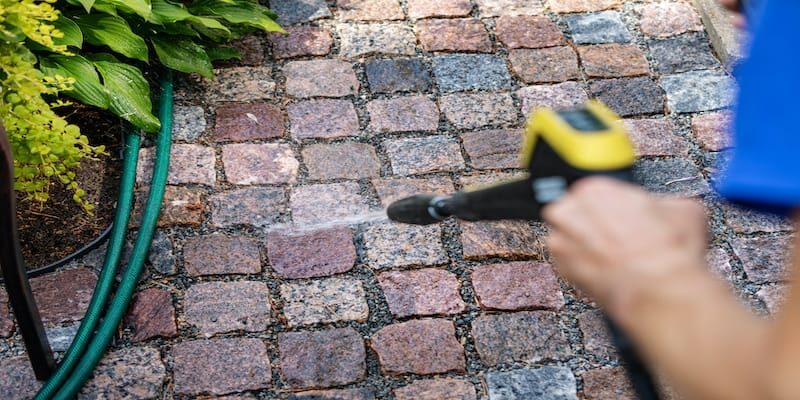Archeologists believe the ancient Romans invented the paver block over 2000 years ago.
While we don’t expect pavers to last for over 2000 years, we do want them to last between 50-100 years if done right. Paver blocks are beautiful and durable, but they have a few problems like tending to lose sand, growing plants in the joints, and causing water runoff problems.
Today, we have innovations for everything under the sun, that includes your pavers.
The Old Way of Cleaning Paver Block
First, let’s go over how you would clean paver block to keep it looking fresh in the old style. People have been using variations of this method for as long as pavers have been around.
It’s tried and true, and keeps it looking great. It’s also a lot of work and a pain in the back.
- Remove anything on top like furniture or potted plants
- Sweep everything off the top with a deck brush
- Remove weeds from between joints
- Treat oil stains with a degreaser solution or poultice
- Use detergents or bleach for shine
- Scrub to get the detergents into all nooks, crannies, and sand
- Rinse with a hose
- Replace sand later when things have dried
You can see these seven to eight steps are labor-intensive, and often take more than a single day.
Think about that when you start shopping for a landscaping company to come in and clean your pavers if you aren’t going to DIY it. You’ll have several people moving everything off, cleaning out the joints, sweeping, and even using leaf blowers. People love shortcuts for everything, but leaf blowers can blue pebbles and rocks with a force that can crack glass or damage paint on cars.
That said, professional landscaping crews can do the work quickly, even if they have to wait around for some detergents and degreasers to work. They can skillfully and knowledgeably replace damaged or misaligned pavers and sand.
There is a better way.
Pressure Washing
Pressure or power washing can be a great way to clean a lot of things, but with paver blocks, it gets a bit tricky. It isn’t the “better way” we were just talking about.
You still need to remove everything from the surface as usual but sweeping isn’t as necessary. It’s still best to remove the plants from the joints by hand, to get the roots.
A lot of people pressure washing see the plants and moss getting blasted away and think the plants are gone. Sorry to say, you only gave them a haircut, and they’ll regrow in a few weeks.
A second point is that while you don’t have to scrub so much, and you can even do a detergent mix in the spray, the pressure for pavers is too much. Pressure washers can go as high as 4000 psi, though for pavers it should be at most between 400-1000 psi and 6-8 gallons a minute.
Pressure washing is often used for large paved areas, on solid concrete. It isn’t intentioned for pavers with all the joints full of sand. You have to take careful attention to not blast that sand out of the joints, not erode or chip your pavers, and still get them clean.
In the end, the first method turns out better than using a pressure washer because of all the repair work, leveling, and you need to refill the kiln-dried sand later.
Out with the Old and in with the New
The better, newer kid on the block is soft washing. Soft washing takes biodegradable detergents and fungicides and takes home cleaning to a whole new level.
Because soft washing doesn’t use high pressure or environmentally damaging solutions, it’s the perfect method for cleaning your pavers. You still need to move furniture and plants to do a thorough job. Otherwise, you can simply spray the solution on, allow it to soak for 15-20 minutes, and remove it.
If you’re concerned about collateral plant damage, the soft wash can be carefully performed and cleaned up.
Soft wash was invented for cleaning roofs and exterior walls without pressure washing. This is to eliminate mold, fungus, and lichen which have different biological makeup than normal plants. While you often hear “bleach” when people talk about a soft wash, it’s different than just spraying bleach.
There are techniques and equipment specializations that apply our cleaning solutions at between 40-80 psi, far below any pressure that would cause damage. It allows us to be surgically precise as well.
What it means is when your pavers are revealed after a soft wash, they’ll look like new. The fungus and moss will have turned white and within a couple of weeks, they’ll naturally decompose and blow away like ash.
Furniture and potted plants are put back on the pavers right away and within an hour, you’ve got a beautifully paved space again.
One way to keep it looking that way is by sealing the pavers at a later date. Everyone loves that wet look, but it can’t always be raining. Paver block sealing protects the pavers, reduces sand runoff, and looks great.
Cleaning Paver Block the Smart Way
Paver block patios and driveways are a beautiful thing to look at.
Now you know how to effectively clean your pavers yourself, or by professionals. Soft washing is a specialized cleaning service that uses specific mixtures of biodegradable solutions to accomplish their tasks, saving your elbow grease for other things.
Far from pressure washing, soft washing is safe for your roof, exterior, patios, and decks, and driveways to keep them looking great for years to come.
We know it’s the best cleaning solution for your home. You probably have more questions. Get in touch today with Outdoor Extreme Clean and let us put you at ease.

